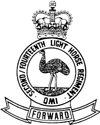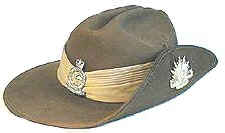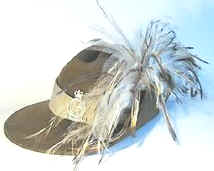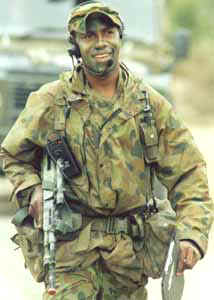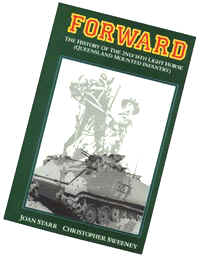- On the 10th July 1899 the Premier of Queensland, the Honourable
J.R. Dickson, offered troops to help Great Britain against the Boers
in South Africa. This was the first offer of assistance made by any of
the Australian Colonies.
-
- It was accepted and one company of Mounted
Infantry was detailed for duty. Although the Queensland contingent was
not the first to see action, they were the first to suffer casualties.
-
Private V.S. Jones and Private D.C. McLeod, killed in an engagement at
Sunnyside, were the first Australians ever to be killed in action,
serving in an Australian Unit.
-
(Some Aussies were killed in New Zealand but they were serving in
British or New Zealand Units)
|
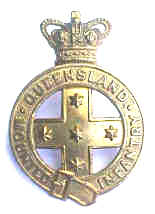 |
|
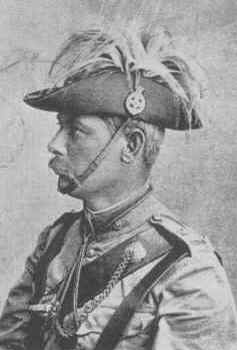
|
|
Major Walter
Tunbridge, CO of the 3rd Contingent Queensland Mounted Infantry,
was a hero of the Siege of Elands River Post, August 1900 |

South
Africa, c. 1900. An informal group portrait of British and
Australian Army officers, include a number of officers of the
1st Queensland Mounted Infantry Contingent.
|
The twelve officers
in this group wearing bush hats with light coloured puggarees
and emu feather plumes are thought to be officers of the 1st
Queensland Mounted Infantry. Identified in the group are:
sitting on a chair on the right holding a rifle, Lieutenant
Colonel (Lt Col) Percy Ralph Ricardo, who commanded the 1st
Queensland Mounted Infantry; the officer squatting on Lt Col
Ricardo's left, and also holding a rifle, is Captain (Capt)
Henry (Harry) George Chauvel, who commanded A Company until he
was appointed Adjutant on 13 February 1900 and the officer
standing 7th from the left is Capt Joseph Espie Dods, Army
Medical Corps and Surgeon to the 1st Queensland Mounted
Infantry. The names of the other officers from the 1st
Queensland Mounted Infantry who could be in the photograph are:
Lieutenant (Lt) Cecil Henry Anderson-Pelham, Capt Reginald
Spence Brown, Lt David Elder Reid, Lt Thomas William Glasgow, Lt
Charles Alexander Cumming, Lt Alfred George Adie, Capt Philip
William Grant Pinnock, Lt Richard Dowse, Lt Henry Bailey, Lt
Robert Gordon and Lt Cecil Herbert Black. (Donor J. E. Dods) |
In the period following the Boer War the State forces were
amalgamated to form the Commonwealth Military Forces. In the changes
the four battalions of the QMI were reformed as the 13th, 14th and
15th Australian Light Horse Regiments (Queensland Mounted Infantry).
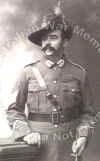 |
Queensland. 1900.
Sgt James Crewford of the 14th Australian Light Horse. |
King Edward VII awarded a King's Banner to each unit which
served in the South African War and in 1904 each of the three
Regiments of the QMI was represented in Melbourne where the banners
were presented by the Governor-General.
In 1908 each regiment was
further awarded the Battle Honour "SOUTH AFRICA
1899-1900-1-2".
|
|
With the introduction of compulsory military service the army
was expanded and in 1912 the designation of the units of the QMI were
again changed to 1st, 2nd, 3rd and 27th Light Horse Regiments (QMI).
During World War 1 these units continued to serve at home and in 1914
a volunteer expeditionary force, the Australian Imperial Force, was
formed.
The 2nd ALH served at Anzac on the Gallipoli Peninsula where
it distinguished itself at Quinn's Post, Sari Bair and Suvla and later
served in Egypt, Palestine and Syria.
|
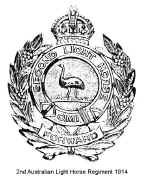 |
Some of the actions in which the Regiment took part included
Romani, Charge of Magdhaba, Rafa, Gaza, Beersheba, Jerusalem, Megiddo
and Jordan.
Battle Honours
| 2nd Light
Horse |
14th Light
Horse |
| SOUTH AFRICA 1899 - 1902 |
SOUTH AFRICA 1899 - 1902 |
| DEFENCE OF ANZAC |
RUMANI |
| SARI BAIR |
MAGDHABA-RAFAH |
| RUMANI |
EGYPT 1916-17 |
| MAGDHABA-RAFAH |
GAZA-BEERSHEBA |
| GAZA-BEERSHEBA |
JERUSALEM |
| JERUSALEM |
JORDAN (ES SALT) |
| JAFFA |
JORDAN (AMMAN) |
| JERICHO |
MEGIDDO |
| JORDAN (AMMAN) |
NABLUS |
| MEGIDDO |
DAMASCUS |
In July 1918 the 1st ANZAC Battalion of the Imperial Camel
Corps, which had fount with the Desert Mounted Corps, became the 14th
Australian Light Horse Regiment. They took part in the final offensive
which overthrew the Turkish right flank in Palestine.
 |
General
Sir Henry George 'Harry' Chauvel, Commander of the Deserted
Mounted Corps, inspecting C Squadron of the 14th Australian Light
Horse Regiment. Note the men are lined up opposite their horses,
their equipment laid out on the ground including the blacksmith
tools/equipment. In the background is Trooper A Howard Toes, the
Standard Bearer to the Commander. |
In 1st Military District (Qld) on 17th August 1918 the units of
the QMI underwent another change. The 1st, 3rd and 27th Light Horse
Regiments became the 5th, 11th and 14th Light Horse Regiments (QMI).
In 1930 as an economy measure, compulsory military service was
abolished and the CMF reverted to voluntary service. As a result, 2nd
Moreton Light Horse (QMI) and the 14th West Moreton Light Horse (QMI)
were linked to form 2nd/14th Light Horse Regiment (QMI).
|
Competing for
the Prince of Wales Trophy 1938
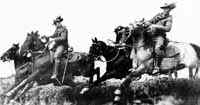
George Reed, Stan Qualischefski, Clive Gutteridge
(Left to right)
|

A
parade of the Regiment on 5th August 1950. Until Anzac Day
2001 it was the last time the guidons had been paraded on
horseback.
|
On the outbreak of World War 2 in 1939 the serving units of
QMI were 2nd/14th, 5th and 11th Light Horse Regiments forming the 1st
Cavalry Brigade. In August 1940 the 2nd/14th Light Horse Regiment was
unlinked and the 14th was raised in Eastern Command as 14th Light
Horse (MG) Regiment. 14th Light Horse (MG) Regiment became 14th Motor
Regiment in March 1942 and was disbanded in May 1942. The troops were
sent to 2nd/4th Armoured Regiment and 3 Army Tank Brigade.
2nd Moreton Light Horse (QMI) changed its name several times to
eventually become 2nd Australian Cavalry Regiment (AIF) and was
finally disbanded in Townsville on 29th July, 1943.
In 1948, CMF units were again raised but with no armoured unit
allocated to Queensland. On 20th July 1949, A Squadron 2nd/14th QMI
was raised as an armoured car squadron. Eighteen months later the unit
was increased to regimental strength and was equipped with Staghound
Armoured Cars, Canadian Scout Cars and White APC's. On 6th August 1950
at Kelvin Grove Barracks, a mounted party of pre-war members handed
over the guidons to the 2nd and 14th Light Horse Regiments to the
unit.
|

